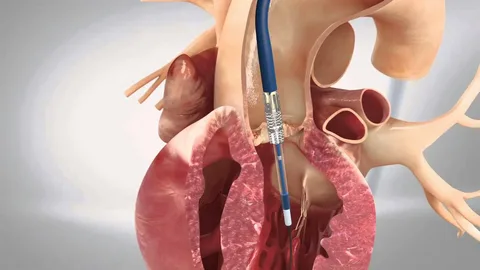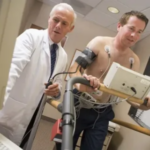
Doctors can replace a damaged artificial aortic valve through a procedure called transcatheter aortic valve replacement. Another name for this procedure is open heart surgery. Our hearts’ aortic valves regulate blood flow, so if the valve becomes stiff, you have a condition known as aortic stenosis. You may get heart failure if the blood flow through the valve becomes uncontrolled. The leading TAVR expert in Mumbai is Dr. Rahul Gupta. In TAVR, medical professionals install a blood artery into your leg to deliver and use with an artificial heart valve. TAVI is another name for TAVR, or transcatheter aortic valve replacement (transcatheter aortic valve implantation).
Why the need for TAVR
TAVR or Transcatheter Aortic Valve Replacement is needed to treat aortic valve disease, which is a condition where the aortic valve in the heart becomes narrowed or partially blocked, leading to reduced blood flow from the heart to the rest of the body. Aortic valve disease can cause a range of symptoms, including chest pain, shortness of breath, and fatigue, and if left untreated, can lead to serious complications, such as heart failure, stroke, and death.
TAVR is a minimally invasive procedure that is designed to replace the damaged aortic valve with a new prosthetic valve using a catheter-based approach, without the need for traditional open-heart surgery. TAVR is generally recommended for patients who are considered high-risk or intermediate-risk for open-heart surgery, as it is associated with a lower risk of complications, reduced hospitalization time, and quicker recovery compared to traditional surgery.
In summary, the need for TAVR arises when an individual has severe aortic valve disease that needs to be treated, and when the patient is not a good candidate for traditional open-heart surgery due to various health reasons.
Risks of TAVR:
Dr. Rahul Gupta, a TAVR specialist in Mumbai, is treating TVARs. He performed several effective open-heart operations. The most typical TAVR risks are:
- Bleeding
- Cardiac arrest
- Failing kidneys
- A replacement valve is leaking.
- Heart attack or heart failure of great severity
- A stroke is caused by a decrease in the blood flow to the brain.
- Blood vessels are harmed.
Depending on your health, there can be additional risks associated with TAVR. Thus, before having the TAVR procedure, make sure to go over everything with the doctor.
How do prepare for TAVR?
Preparing for TAVR or Transcatheter Aortic Valve Replacement involves several steps to ensure that the procedure is safe and successful. Some of the things that patients can do to prepare for TAVR include:
- Medical evaluation: Patients will need to undergo a medical evaluation to assess their overall health and determine if they are a good candidate for TAVR. This evaluation may include various tests such as an echocardiogram, electrocardiogram, chest x-ray, and blood tests.
- Medication management: Patients will need to work with their healthcare provider to manage any medications they are taking, as some medications may need to be adjusted or stopped before the procedure.
- Fasting: Patients will need to fast for several hours before the procedure, typically starting at midnight the night before.
- Psychological preparation: Patients may need to undergo psychological counseling to help prepare them for the procedure and to manage any anxiety or stress.
It is important to follow all instructions given by the healthcare team to ensure a safe and successful TAVR procedure.
What happens during TAVR?
TAVR or Transcatheter Aortic Valve Replacement is a minimally invasive procedure used to treat aortic valve disease. Here is what happens during the TAVR procedure:
- Anesthesia: The patient is given general anesthesia, which puts them to sleep, or conscious sedation, which relaxes them but keeps them awake.
- Catheter insertion: The surgeon makes a small incision in the groin or chest area and inserts a catheter into an artery.
- Guidewire insertion: A guidewire is passed through the catheter and into the heart, and then across the diseased aortic valve.
- Valve placement: A balloon catheter is then inserted over the guidewire and positioned across the diseased valve. The balloon is then inflated, which expands the new valve into place.
- Valve deployment: Once the new valve is in position, the balloon catheter is deflated and removed, and the new valve begins to function.
- Catheter removal: The catheter is removed, and the incision site is closed.
The entire procedure takes about 1-2 hours, and most patients are able to go home within a few days. TAVR is associated with a lower risk of complications, reduced hospitalization time, and quicker recovery compared to traditional open-heart surgery.
What happens after TAVR?
After the TAVR procedure, the patient is monitored closely in the hospital for the first few days. Here’s what happens after TAVR:
- Recovery: Patients are moved to a recovery area where they are monitored for a few hours or overnight, depending on the hospital protocol.
- Follow-up tests: Doctors perform several tests, including an echocardiogram and an electrocardiogram (ECG), to ensure that the new valve is functioning correctly.
- Medications: Patients are given medications to manage pain, prevent blood clots, and reduce the risk of infection.
- Rehabilitation: Patients are advised to start moving and walking around as soon as possible to promote blood flow and reduce the risk of blood clots.
- Discharge: Most patients are discharged from the hospital within a few days and are advised to take it easy for the next few weeks.
- Follow-up appointments: Patients need to schedule follow-up appointments with their cardiologist to monitor their progress and ensure that the new valve is functioning correctly.
Overall, patients who undergo TAVR experience a quicker recovery time and a shorter hospital stay compared to traditional open-heart surgery.




